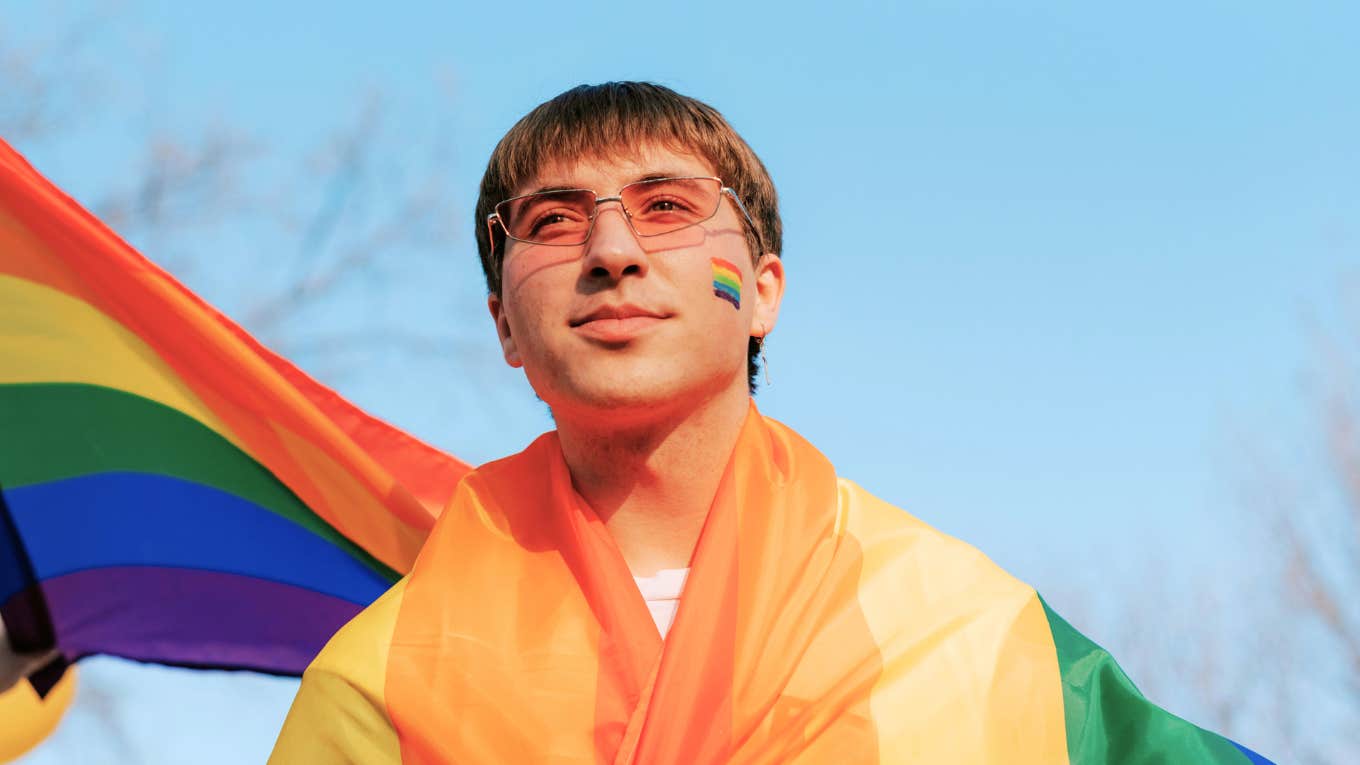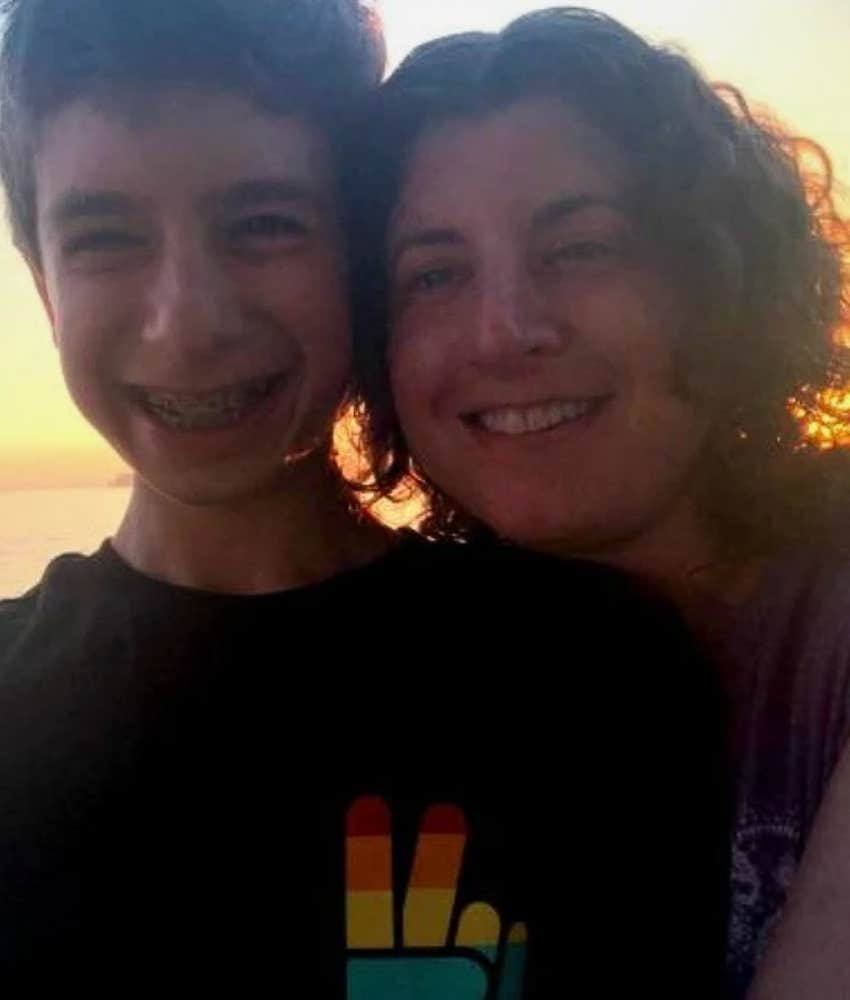Mom Of A Boy Bullied For Being Gay Shares 9 Ways Parents Can Help Stop Anti-LGBTQ Bullying
Your kids will hear homophobic slurs and hate speech and they need to know how to respond.
 Kateryna Hliznitsova | Unsplash
Kateryna Hliznitsova | Unsplash “Move it, gay boy!” a classmate told my 14-year-old son as he walked up the middle school stairway. Another kid told his lunch table, as a joke, that he was dating my son. And yet another insisted to my son that being gay is a choice.
Kids like my son are far from alone when it comes to their experiences with bullying in schools. LGBTQ youth are bullied every day as they simply try to get an education in a place they're supposed to feel safe.
What would you do if your kid were the one being bullied, or if you knew your kid was the one being a bully to other children? After all, it's up to parents to learn how to stop bullying and teach kids to treat their fellow humans with dignity and respect.
Mom of a boy bullied for being gay shares 9 ways all parents can help stop anti-LGBTQ bullying:
1. Know how common anti-LGBTQ bullying is
The sad reality is that "Almost all of LGBTQ students (98.5%) heard 'gay' used in a negative way (e.g., 'that’s so gay') at school [and] 95.3% of LGBTQ students heard other types of homophobic remarks," according to the 2017 National School Climate Survey conducted by the Gay, Lesbian & Straight Education Network (GLSEN), self-identified as the leading education organization working to create safe and inclusive K-12 schools for LGBTQ youth.
The study also revealed that 94 percent of LGBTQ students "heard negative remarks about gender expression," 87.4 percent "heard negative remarks specifically about transgender people," 56.6 percent heard "homophobic remarks from their teachers or other school staff," and 71 percent heard "negative remarks about gender expression from teachers or other school staff."
It's not hard to imagine the subsequent trickle-down effect that surfaces as more frequent school absences, lower GPAs, reduced likelihood of pursuing a college education, lower self-esteem, and higher levels of depression. In fact, LGBTQ+ youth seriously contemplate suicide at a rate nearly three times that of heterosexual youth.
As the 2017 National Youth Risk Behavior Survey (YRBS) from the Centers for Disease Control (CDC) found, "The prevalence of having seriously considered attempting suicide was higher among gay, lesbian and bisexual (47.7%) and not sure (31.8%) than heterosexual (13.3%) students and higher among gay, lesbian, and bisexual (47.7%) than not sure (31.8%) students."
2. Understand words hurt, and it is intentional
 Photo courtesy of the author
Photo courtesy of the author
Talking to my high school freshman about his middle school experience was eye-opening, even for me. He said he started noticing other kids using the word “gay” as a slur all the time at some point during middle school. He did offer the disclaimers that it wasn't meant in a way that targeted others, and was used mostly among boys.
“Oh, that’s gay,” they’ll say. Or, “You’re so gay!” Sometimes they don’t say the word explicitly, but imply it. For instance, if there is a boy in school named Jack whom the students believe to be gay, instead of saying, “Jack likes boys,” they will use an acronym like “JLB.”
My son estimates that about 75 percent of the boys in his eighth-grade class did this or something like it. There was even a meme going around at one point where boys said, “I love you bro, but no homo.” Some kids don’t say these words often, my son said, but they go along with it because if people think it’s funny, they don’t care that saying it’s not OK.
3. Realize bro-code is enforced early
My son actually talked to one classmate about the behavior he’d seen, and he also reported it to administrators via an online bullying form on the school's website. When his classmates asked if he was the one who reported it, to his credit, he had no compunction in saying yes. In response, he was told he was too sensitive and that it was just a joke. Rather than being apologetic, his completely unaware classmates were upset with him for “tattling” on them.
Occasionally, a kid will turn to my son and say, “You’re gay.” His response is simply, “Is that a bad thing?” Sometimes he says this so quietly he’s barely heard, while other times, he’s heard but ignored. Never once has he received a word in response.
4. Don't think teachers and admin are exempt from being bullies
Sometimes, my son's concerns over bullying in his school run deeper. And he's not wrong in being afraid. “What if a teacher also feels this way?” my son asked. “They might not report what they hear.”
I asked what he thinks is needed to improve the situation. In addition to better enforcement and faculty training, he said that, at the very least, early education is needed. It’s important to educate kids as early as possible.
As parents, we’re role models for our children. If we treat LGBTQ people as we treat everyone else, they’ll do that too. If we promote sensitivity and teach our kids about the world and its differences, they’ll internalize this, and it will be expressed externally in their own behavior.
5. Facilitate change at home, and act as an LGBTQ ally openly and in public
Education leads to awareness, understanding, and acceptance. And after all, you never know if your child or your child’s friend will need this support someday. With anti-LGBT hate speech and hate crimes on the rise, global support is more important than ever.
“The reality is that all children live in an increasingly diverse world in which LGBTQ+ people are their friends, family members, and neighbors — and the more we as parents can do to prepare our children to understand and appreciate this diversity, the more successful they will be regardless of their own identities as they mature,” says Ellen Kahn, Director of the Children, Youth and Families Program at the Human Rights Campaign (HRC).
Ironically, I couldn’t find much information on how to teach kids about LGBTQ issues to prevent them from becoming bullies and/or to feel safe with their own sexuality if they want to come out.
However, there’s a lot of guidance about what schools can do that can be adapted for the sake of teaching your own kids at home, including the following suggestions:
- Educate yourself, which includes learning and using appropriate language and terminology, as well as avoiding inappropriate words and phrases. PFLAG, the nation’s first and largest organization for LGBTQ+ people, their parents, families, and allies, has a list of LGBTQIA+ terminology that can be helpful.
- Refrain from making assumptions when it comes to people’s gender and sexuality.
- Be inclusive.
- Speak up when you see anti-LGBTQ+ behavior.
- Create teachable moments.
- Be public — make clear that you’re a LGBTQ+ advocate and ally.
- Demand LGBTQ-inclusive curriculum be taught at your children's schools.
“We can speak early with children by talking about different types of family structures, using gender-neutral language when talking about relationships and marriage, and saying affirming things about the LGBTQ community," Kahn says. "Being neutral or avoiding the topic entirely can send a message to children that they can’t talk about sexual orientation or gender identity, and that is especially dangerous for LGBTQ children."
That's what my husband and I have tried to do with our children.
6. Stop reinforcing gendered expectations
When my daughter was born, I was inducted into the world of gendered clothing. I eschewed all things pink by way of protest. When my son came along three years later, I had no problem with him dressing up in the princess outfits my daughter had received as gifts.
From the beginning, my husband and I spoke positively, though not explicitly, about LGBTQ issues around our kids. We wove into dinner table conversation on related current events and talked about our LGBTQ+ friends just like we would any other friends.
Whenever we referenced the future, we always made sure not to assume that our kids were straight. For instance, we would say, “When you have a girlfriend or boyfriend someday ...,” instead of presuming they'd end up in exclusively heterosexual relationships.
I like to think it’s because our son knew we were receptive, open, and supportive that he was able to come out to us in elementary school. Now he’s been out for several years. Unfortunately, other children grow up without this kind of background. Some become bullies, and others don’t understand how to be good allies. Some may be LGBTQ, but feel unsafe coming out.
7. Don't ignore it if you hear your child using an anti-LGBTQ slur
As the website for the HRC’s Welcoming Schools program says, “If you have the time and opportunity to educate on the spot, do it. If you don’t, make time later.” In fact, that entire site is full of fantastic suggestions for how to talk to your kids about anti-gay hate speech.
Most importantly, be clear that using these words is disrespectful. Make sure your child knows what the words mean, why they’re so negative, and how much it hurts people to hear them. In addition, remind your child that they can never know for sure which of their own friends or classmates is LGBTQ+. Those kids need to hear their peers speaking up when they witness bullying or hate speech.
It could literally save an LGBTQ+ kid’s life to see that not everyone thinks homophobia is OK. You never know who’s listening!
8. Follow through if you learn your child has been bullying or using anti-LGBTQ slurs
Thank the messenger for telling you the truth. Make it clear that you don’t subscribe to hate speech and will educate your child. Then, follow through.
You can use some of the tips above and talk to your child’s teachers and guidance counselors so they’re aware and alert. Make clear that this kind of language and behavior is unacceptable, and set natural consequences for your child should they do this again.
9. Be proactive about anti-LGBTQ language at your kids’ school
In addition to educating your child about what homophobic language is and why it’s harmful, reach out to the school to suggest an educational program for all students. You can also inquire as to whether the school has an inclusive, anti-hate policy. As GLSEN notes, queer kids at schools that have an LGBTQ curriculum are more likely to feel safe there, ultimately leading them to better educational outcomes.
The bottom line is this: It’s important to raise your kids to be kind. Kindness goes a long, long way in making the world a better place for everyone. The good news is, you can be a supportive parent either way and raise kids who know how and want to be good allies to the LGBTQIA+ community.
Lisa A. Goldstein is a freelance journalist whose work has appeared on Mashable, Backchannel, them, Hearing Like Me, Romper, and more. She now has two kids in high school so wish her luck.

